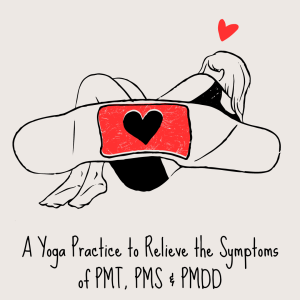Premenstrual tension (PMT), premenstrual syndrome (PMS), and premenstrual dysphoric disorder (PMDD) are conditions that affect millions of women worldwide, causing a range of physical and emotional symptoms before menstruation. These conditions can disrupt daily life and well-being (so much!), but holistic approaches like yoga can be used to manage and alleviate the symptoms. Yoga is known for its ability to promote relaxation, reduce stress, and enhance physical and mental well-being, and this is how it can be best utilised when you are experiencing PMT, PMS and PMDD.
Yoga offers a holistic approach to managing the symptoms of PMT, PMS, and PMDD, providing relief for both the body and mind. By incorporating yoga into your routine, you can cultivate a greater sense of balance, resilience, and well-being, empowering you to navigate the ups and downs of the menstrual cycle with greater ease and grace.
In this post, we’ll explore how incorporating yoga into your routine can offer relief from PMT, PMS, and PMDD symptoms (and I have recorded a class you can download, keep and do on a regular basis). I must emphasise, though, that yoga isn’t going to fix everything, it’s important to explore other healing modalities and advice and help from professionals.
Understanding PMT, PMS, and PMDD
PMT, PMS, and PMDD are conditions characterised by a combination of physical, emotional, and behavioural symptoms that occur in the days or weeks leading up to menstruation. These symptoms can vary widely among individuals but may include mood swings, irritability, fatigue, bloating, headaches, changes in appetite, and sleep disturbance.
While PMT and PMS are more common and typically less severe, PMDD is a more severe form of premenstrual syndrome, characterised by debilitating mood swings, severe depression, irritability, and other symptoms that significantly interfere with daily functioning. Other symptoms can include nervousness, a feeling of lack of control, anger, insomnia, bloating and fluid retention, fatigue, anxiety, difficulty concentrating and poor self-image… and if that isn’t enough, respiratory problems.
How Yoga Can Help
Stress Reduction: Yoga emphasises deep breathing, meditation, and mindfulness, all of which can help reduce stress levels. By calming the mind and promoting relaxation, yoga can alleviate the psychological symptoms associated with PMT, PMS, and PMDD.
Hormonal Balance: Certain yoga poses stimulate the endocrine system, which is responsible for hormone production and regulation. Poses such as inversions and twists can help balance hormone levels, potentially reducing the severity of symptoms experienced during the menstrual cycle.
Pain Relief: Many yoga poses focus on stretching and strengthening the muscles, which can help alleviate menstrual cramps and other physical discomfort associated with PMT, PMS, and PMDD. The physical poses can also help with relieving fluid retention.
Mood Enhancement: The mind-body connection central to yoga practice can promote a sense of emotional well-being and stability. Yoga encourages self-awareness and acceptance, empowering individuals to manage their mood swings and emotional fluctuations more effectively.
Improved Sleep: Sleep disturbances (and serotonin deficiency) are common symptoms of PMT, PMS, and PMDD. Yoga promotes relaxation and can help improve sleep quality and seratonin creation, allowing individuals to feel more rested and better equipped to cope with their symptoms, and improving sleep.
Balancing and clearing the Sacral Chakra:
In particular, yoga poses that target the Sacral Chakra, the energy center located in the lower abdomen, can play a significant role in alleviating symptoms and restoring balance during this time. The Sacral Chakra, also known as Svadhisthana in Sanskrit, is associated with emotions, creativity, sensuality, and the reproductive system. Located in the pelvic area, just below the navel, this energy centre governs our ability to experience pleasure and navigate the ebb and flow of emotions. When the Sacral Chakra is balanced, we feel emotionally stable, creative, and connected to our sensual selves. However, imbalances in this chakra can manifest as mood swings, emotional instability, and reproductive issues, which are common features of PMT, PMS, and PMDD.
Practicing yoga poses that focus on the Sacral Chakra can help release tension, stimulate energy flow, and promote emotional well-being. Here are some poses to incorporate into your practice:
Bound Angle Pose (Baddha Konasana): This pose opens the hips and pelvis, releasing tension in the lower abdomen and groin area. Sitting with the soles of the feet together and knees bent, gently fold forward to deepen the stretch and connect with the breath.
Cat-Cow Pose (Marjaryasana-Bitilasana): Flowing between Cat and Cow poses helps to awaken the spine, increase circulation to the pelvic region, and relieve menstrual cramps. Move mindfully with each breath, arching and rounding the back sequentially.
Wide-Legged Forward Fold (Prasarita Padottanasana): This pose stretches the inner thighs and groin while calming the mind and reducing stress. Stand with feet wide apart, hinge at the hips, and fold forward, allowing the head to relax towards the floor.
Reclining Bound Angle Pose (Supta Baddha Konasana): Lie on your back with the soles of the feet together and knees bent, allowing the knees to open to the sides. This gentle backbend opens the chest and abdomen, promoting relaxation and surrender.
Incorporating Yoga into Your Routine
Start Slow: If you’re new to yoga, begin with gentle, beginner-friendly poses and gradually increase the intensity as you become more comfortable and confident in your practice. While cardio exercise has been shown to be of benefit when dealing with symptoms of PMT, PMS and PMDD, I recommend using a gentle-style yoga so you can cultivate mindfulness, self-compassion and self-kindness, and stress relief, which will be a huge contribution to relieving your symptoms.
Consistency is Key: Aim to incorporate yoga into your routine regularly, ideally practicing several times per week. Consistency is essential for reaping the full benefits of yoga for PMT, PMS, and PMDD symptom management. Here is a class I have recorded that you can purchase, download and keep.
Listen to Your Body: Pay attention to how your body responds to different yoga poses and adjust your practice accordingly. Honour your body’s limitations and avoid pushing yourself too hard, especially during times of increased sensitivity before menstruation.
Seek Guidance: We are all different, and the symptoms definitely vary from person to person and also vary in intensity. Organise a one-on-one session with Suze of 42 Yoga to work on your individual issues.
Other Things You Can Do
Meditate – Try a free app like Insight Timer, which has thousands of guided meditations. Try guided meditations on clearing and balancing the Sacral chakra, stress and anxiety relief, and self-love, self-compassion and self-kindness. Meditation and guided visualisation techniques can also promote emotional healing and support overall well-being. Try combining a meditation with your yoga practice.
Focus on the breath – Integrating breathwork and mindfulness practices into your yoga routine can enhance the benefits of balancing the Sacral Chakra. Deep, diaphragmatic breathing helps to calm the nervous system, reduce stress, and cultivate a sense of inner peace.
Listen to healing sounds – Listen to healing binaural music that focusses on the Sacral Chakra and its vibrational frequencies. You can listen to the music while you are practicing yoga, in your day-to-day life, or at night when you are going to sleep. Here is a playlist I have put together on Spotify…
Exposure to bright light – try doing your yoga class outside in the sunshine. I recommend exposure to sunlight first thing in the morning, so that is an ideal to do your regular yoga practice.
Create a relaxing atmosphere – Use candles, incense and music to create a relaxing atmosphere. Turn off your phone and, if you can, create time and space where you will not be interrupted.
Photo by Abigail Keenan on Unsplash


